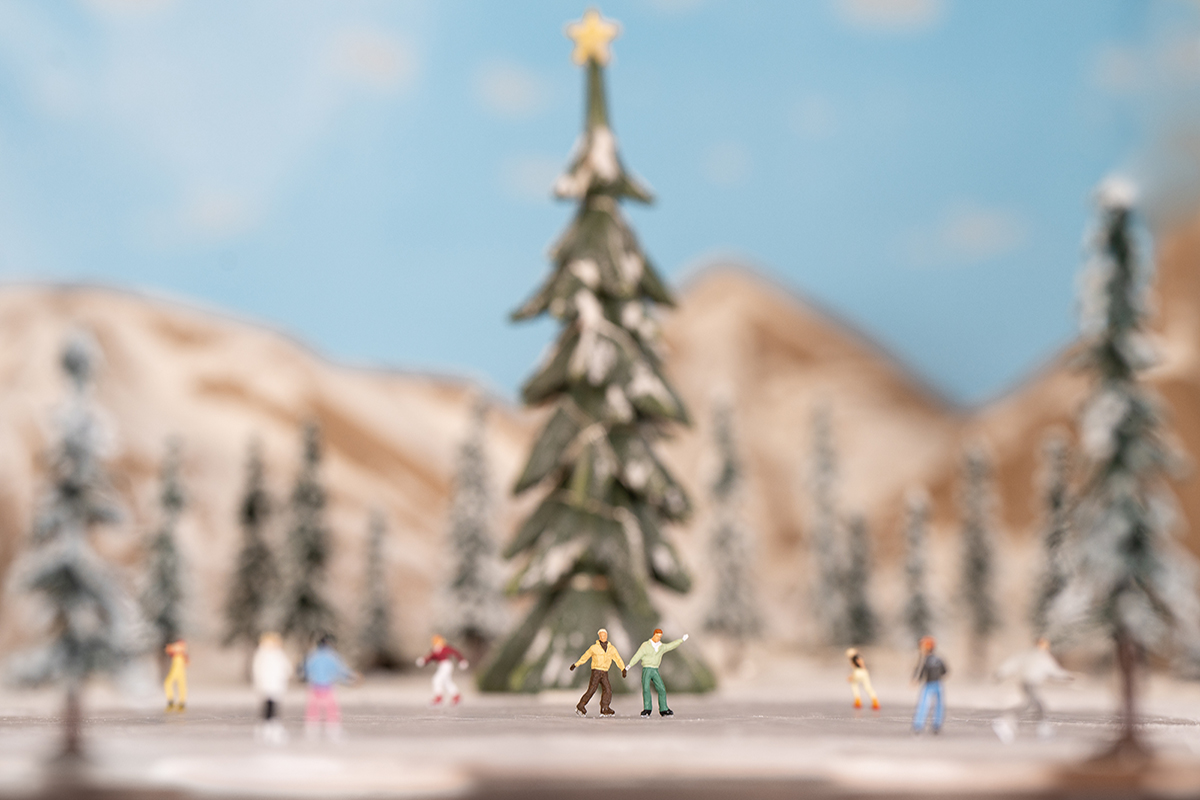Tiny Worlds, Big Adventures
Al Baker uses his Tamron 28-75mm F/2.8 G2 and 70-180mm F/2.8 lenses to photograph miniature figurines on handmade landscapes.
Share the article:
More Photo Tips | Video Gallery | Photo Gallery | Enewsletter sign-up
By Jenn Gidman
Images by Al Baker
When Al Baker was a teenager living in Florida, he fell in love with playing pool. He even went pro, competing in some of the most elite tournaments in billiards. “Then, one day, I realized I’d fallen out of love with it,” he says. “I wanted to find something that inspired the same passion in me that pool once had.”
Al’s grandfather, a photographer, had passed down a bunch of antique cameras and an older Canon to his grandson, and Al took the latter with him on a trip to the Smoky Mountains in 2014. “That trip spurred my love for travel photography,” he says. “As soon as I came home, I sold a couple of my custom billiards cues, which can run a few thousand dollars each, and bought a newer DSLR for myself. I took a trip to New York City to try my hand at street photography, and I loved that so much that I upgraded even more, buying the best camera I could at the time.”
Today, Al lives in Las Vegas and specializes in landscape and adventure photography, which was basically put on hold for him during the pandemic. While in lockdown, Al started dabbling in an entirely different genre instead: taking pictures of miniatures. “I was online and stumbled upon the work of Erin Sullivan, who takes these kinds of photos,” he says. “I wanted to roll with that idea, because I was so bored while stuck at home. I had all the time in the world to create and keep improving upon my previous work, making each set look more realistic than the last. I kept at it for months, and now I don’t think I’ll ever stop.”
Read on for a Q&A with Al on his miniature photography work.
On the surface, this type of photography seems very different from landscape photography. But in another way, you’re drawing inspiration from the images you were taking before—except now it's mini-adventures taking place on manufactured landscapes.
Exactly. When I was a kid, I was always building all sorts of things. Creations out of Legos, baseball stadiums or wrestling arenas out of cardboard—whatever my imagination could dream up. Doing this now brings me back to those days and infuses me with a very nostalgic feeling.
Tell us about the Tamron lenses you use to photograph your miniature sets.
I’ve been using the 28-75mm F/2.8 Di III VXD G2 standard zoom, as well as the 70-180mm F/2.8 Di III VXD telephoto. Thanks to a Minimum Object Distance (MOD) of 7.1 inches at the 28mm end, with a maximum magnification ratio of 1:2.7, I can get closer to the miniatures than I’ve been able to in the past.
And with the wide-open apertures I’ve got with both of these lenses, I’m able to achieve a very shallow depth-of-field that is perfect for my work. If I’m using a background like, say, a poster board with clouds on it, I don’t have to buy a 10-foot background. I can pick up a 3-by-1-foot board and then play around with the depth-of-field to give the background the appearance of being something much larger than it is, simply by blurring it out and filling the frame with it.
Both of these lenses are also so lightweight and easy to carry around, which is great not only for my miniatures, but also for when I’m traveling—especially for my rock-climbing adventures, when I’m going up on a line and need to carry as little weight as possible.
You build the models and sets yourself?
I don’t make the miniature figurines. Those are hobby train figures that I purchase online and then paint myself. They come in all different sizes—the ones I typically use are about the size of my fingertip, as you can see from one of the behind-the-scenes photos here.
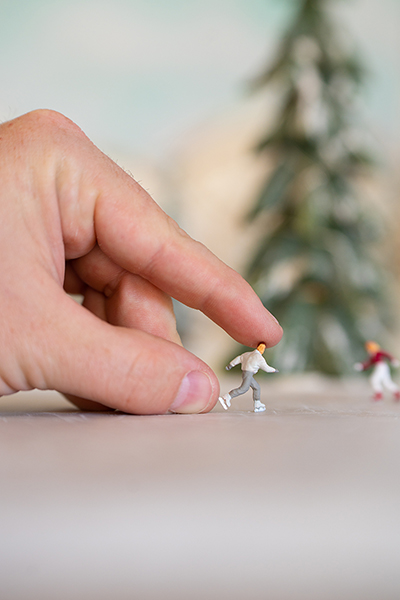
70-180mm (87mm), F/3.5, 1/13 sec., ISO 320
Click image to view larger
When it comes to the sets, I pull them together out of regular household items and other knick-knacks. I’ll use rocks from my yard, brown wrapping paper to create mountains, miniature trees that you can buy at any craft store or online. For this particular set, I sifted flour over the scene as “snow.”
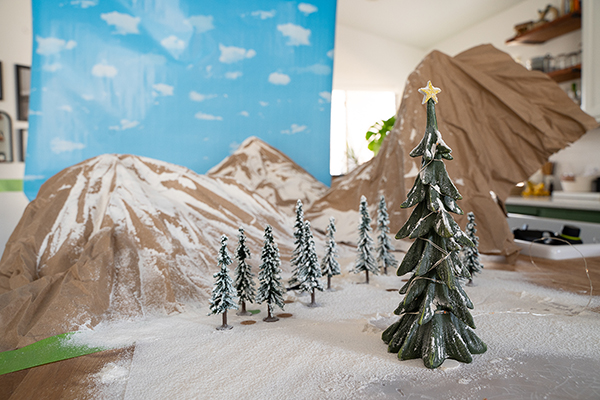
28-75mm (28mm), F/7.1, 1.8 sec., ISO 640
Click image to view larger
How long does it take you to build the sets?
It varies, depending on the scene, but this Christmas-themed set took me about 45 minutes to an hour, if you take into account the breaks I took. It actually takes longer to plan everything and decide on how I want to frame the scene out than to build the set itself.
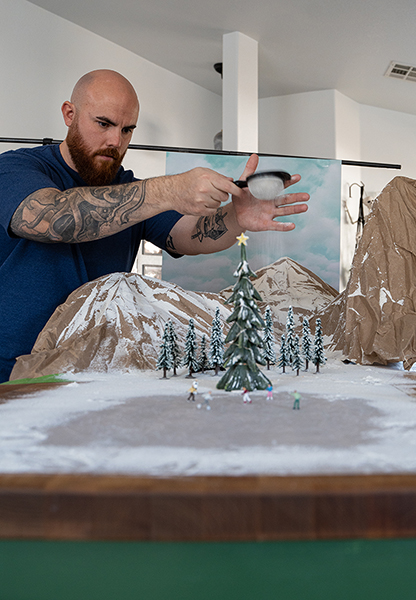
28-75mm (28mm), F/4.5, 1/30 sec., ISO 800
Click image to view larger
Do you use a tripod or shoot handheld?
I use a tripod most of the time for my miniatures photos. This is especially true for the nighttime shots. To get everything as clear as possible, I’ll usually use a 100 ISO and a shutter speed of anywhere between a couple of seconds to 15 or even 30. Being able to shoot wide open on both of those F/2.8 Tamron lenses comes in particularly handy during lower-light situations.
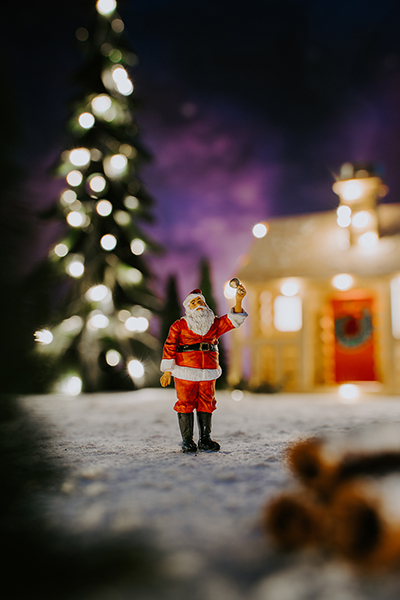
28-75mm (36mm), F/5.6, 3.2 sec., ISO 100
Click image to view larger
Talk about your lighting setup.
For most of the ice-skating shots, or for any of my miniatures that I’m photographing in the daytime, I simply use natural light that comes in through my home’s windows. When I shoot at night, I use whatever lighting is available. I also have a string light, which is a wire with tiny beads of light on it, that I used for this holiday shoot. I placed that lighting in front of the set to lend the scene more of a warm, Christmas-like illumination. I also have a star-printed poster board that I placed behind the set and then backlit with a studio light, so it looks like a sky with stars in the background.

70-180mm (123mm), F/5.6, 2.5 sec., ISO 100
Click image to view larger
How do you figure out what you’re going to include in the scenes, and then how to shoot them?
For this particular Christmas setup, I was strictly going for a holiday feel. But typically I try to base my creations on other photographs I’ve taken of real places. The destinations I’ve visited continue to inspire me.

70-180mm (88mm), F/5, 1/10 sec., ISO 320
Click image to view larger
Angles are important in this kind of photography. I try to get as low as possible to put the viewer at eye level with the “people” in the photo. I want the viewer to feel like they’re in the scene, too, and that it’s a real Santa or group of ice skaters in front of them. I’ve played around with other perspectives, like shooting from above, but it’s hard to get higher and make the scene look real. When you’re working with miniatures, even a slight shift in the POV can drastically change how realistic everything looks.
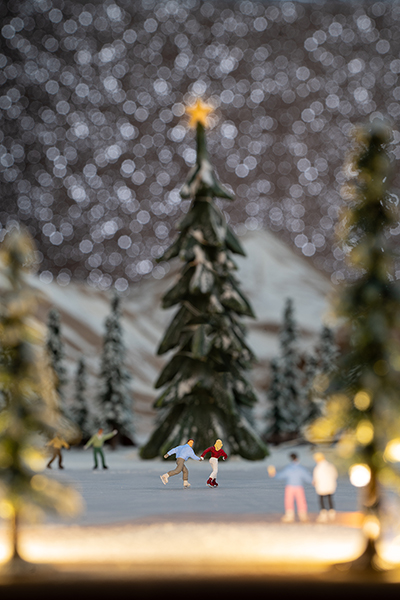
70-180mm (82mm), F/10, 15 sec., ISO 100
Click image to view larger
What’s the most challenging part of this type of photography?
To be honest, I feel like it’s actually easier than my usual adventure photography. When I’m out taking nature or landscape pictures, it’s not like I can just move the elements around in the frame and place them exactly where I want them. Figuring out the best way to build the sets was somewhat of a learning curve, but I now know I don’t have to get super-technical with my construction, as it’s pretty easy to create the sets using everyday items. I don’t have to do much with them—because I use low apertures to blur out the backgrounds, I’m able to make these elements look more “real” with my camera.
So has what was once a side project now become your main passion?
I still love traveling, and now that we’re not locked down anymore, I’m starting to pick up that kind of work again. But it’s nice to be able to dabble in the miniature photography when I’m home and get the itch to create a set. Thankfully, my wife understands how I feel about creating these kinds of photos, because I tend to make a mess in the kitchen or garage when I’m putting it all together. As long as I clean up that mess afterward, she’s fine with it!
To see more of Al Baker’s work, check out his website and Instagram.
More Photo Tips | Watch Videos | Learn More About Tamron Lenses | Photo Gallery
